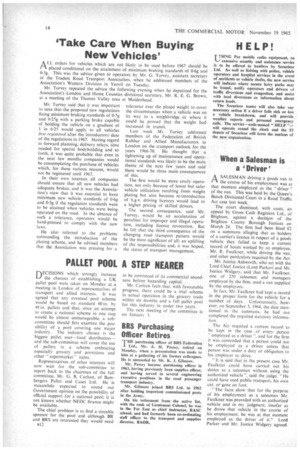'Take Care When Buying New Vehicles'
Page 16

If you've noticed an error in this article please click here to report it so we can fix it.
ALL orders for vehicles which are not likely to be used before 1967 should be placed conditional on the attainment of minimum braking standards of 0.6g and 0.3g. This was the advice given to operators by Mr. G. Turvey, assistant secretary of the Traders Road Transport Association, when he addressed members of the Association's Western Division in Yeovil on Tuesday.
Mr. Turvey repeated the advice the following evening when he deputized for the Association's London and Home Counties divisional secretary, Mr. R. E. G. Brown, at a meeting of the Thames Valley area at Maidenhead.
Mr. Turvey said that it was important to note that the proposed new regulations fixing minimum braking standards of 0.5g and 0.25g with a parking brake capable of holding the vehicle on a gradient Of 1 in 6-25 would apply to all vehicles first registered after the introductory date of the regulations in 1967. Having regard to forward planning, delivery relays, time needed for special bodybuilding and so forth, it was quite probable that even in the next few months companies would be contemplating the purchase of vehicles which, for these various reasons, would not be registered until 1967.
In their own interests all companies should ensure that all new vehicles had adequate brakes, and it was the Association's view that it was essential to have minimum new vehicle standards of 0.6g and 0.3g if the regulation standards were to be attained when vehicles were being operated on the road. In the absence of such a tolerance, operators would be hard-pressed to comply with the new laws.
He also referred to the problems surrounding the introduction of the plating scheme, and he advised members that the Association was pressing for a tolerance over the plated weight to cover the circumstances when a vehicle was on its way to a weighbridge or where it could be proved that the weight had increased in transit.
Last week Mr. Turvey addressed members of the Federation of British Rubber and Allied Manufacturers in London on the transport outlook for the years 1966-70. He thought that a tightening up of maintenance and operational standards was likely to be the main theme of the next few years and said there would be three main consequences of this.
The first would be more costly operation, not only because of lower but safer vehicle utilization resulting from weight plating but also because re-introduction of h.g.v. driving licences would lead to a higher pricing of skilled drivers, The second consequence, said Mr. Turvey, would be an acceleration of penalties for improper and illegal operation, including licence revocation. But he felt that the third consequence of the changing road transport pattern would be the most significant of all: an uplifting of the responsibilities and, it was hoped, the status of transport management.
















































































































































